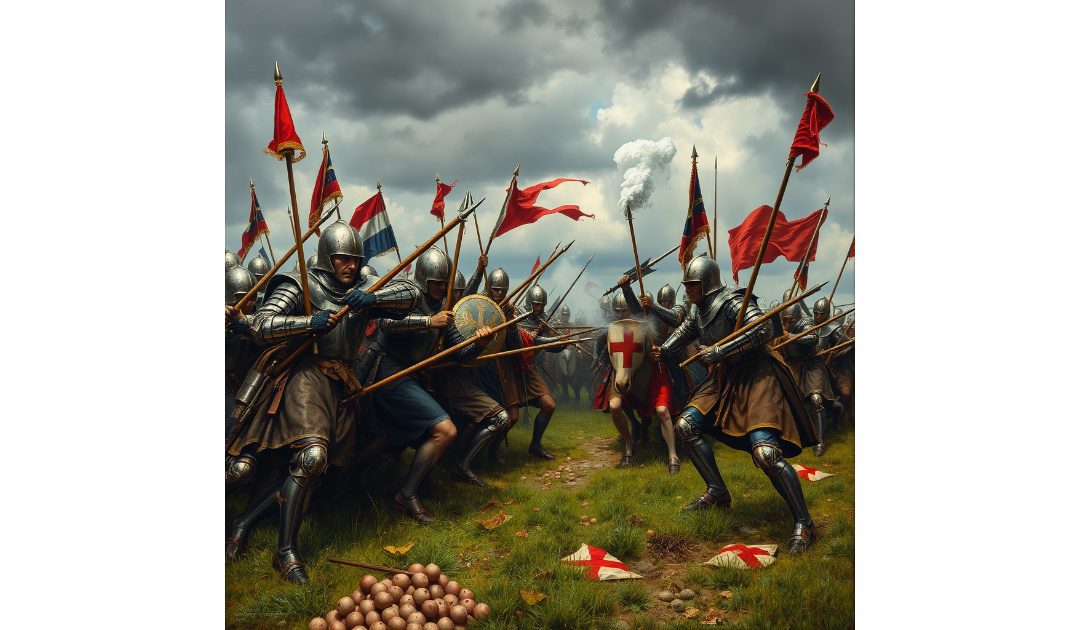The Battle of Formigny was fought on the 15th of April, 1450, and marked a significant turning point in the latter stages of the Hundred Years’ War between England and France. This conflict, which lasted from 1337 to 1453, was characterised by a series of battles over the control of the French throne, involving a complex web of alliances and the dynamic changes in medieval warfare tactics. I have written about the Eighty Years’ War, because my ancestor, Sir Anthony Standen, was involved, spying for Francis Walsingham. But today we shall look at the Hundred Years’ War, and the Battle of Formigny.
By the mid-15th century, the tide of the Hundred Years’ War had shifted in favour of France. The English, who had initially been successful, were struggling to maintain their territories in Normandy and other parts of France. The Battle of Formigny was a crucial engagement during the French reconquest of Normandy.
The English forces in Normandy were under pressure after the fall of Rouen in October 1449. The French, led by Charles VII, embarked on a campaign to reclaim Normandy, which had been under English control for decades. The battle took place near the village of Formigny, which is located in present-day Calvados, Normandy.
The French army was commanded by Charles, Count of Clermont, who was later joined by Arthur de Richemont, the Constable of France. These leaders were experienced and capable, with Richemont bringing reinforcements that would prove pivotal in the battle.
The English forces were led by Sir Thomas Kyriell. His army, although well-disciplined, was considerably outnumbered. Kyriell had landed in France with reinforcements to aid the besieged strongholds, and his forces included veteran soldiers, many of whom had seen fighting in earlier stages of the war.
The confrontation began when the English, marching towards the garrison at Caen, encountered the French forces near Formigny. Initially, the English held the advantage through their strategic positioning and the effective use of longbows, which had been a staple of English military success throughout the war.
However, this advantage was undermined by the arrival of Richemont’s reinforcements, which included a significant number of field artillery pieces. The French guns played a crucial role in disrupting the English formations, which had been a primary tactic for maintaining defensive positions.
Richemont’s forces attacked from the rear, creating a pincer movement that caught the English between two well-coordinated French forces. The artillery bombardment, combined with the cavalry charges executed by Clermont and Richemont, gradually wore down the English positions.
As the battle progressed, the French forces began to gain the upper hand. The English lines were eventually broken, leading to a chaotic retreat. Many English soldiers were killed or captured, including their commander, Sir Thomas Kyriell. This decisive victory for the French effectively ended English resistance in Normandy.
The outcome of the Battle of Formigny was a critical step in the French reconquest of Normandy. It demonstrated the growing effectiveness of artillery in battles, a factor that would increasingly define military engagements in the latter half of the 15th century.
Following the battle, the French continued their campaign to reclaim Normandy, capturing Caen in June 1450 and Cherbourg by August 1450. The loss of Normandy was a severe blow to English prestige and marked the beginning of the end for English territorial ambitions in France.
Historically, Formigny is seen as one of the battles that signalled the decline of English power in France, leading to the eventual conclusion of the Hundred Years’ War with the French victory at the Battle of Castillon in 1453.
The Battle of Formigny is often cited as an example of the transition in medieval warfare from reliance on traditional infantry and cavalry to the integration of artillery. This shift would come to dominate military tactics in the coming centuries. The battle also underscored the importance of tactical leadership and the ability to adapt to changing battlefield conditions, something the French commanders demonstrated effectively.
In the broader context of the Hundred Years’ War, Formigny and the subsequent French victories were pivotal in consolidating the power of the French monarchy, laying the groundwork for a unified and strengthened France. The defeat contributed to internal challenges in England, including the Wars of the Roses, which further distracted the English from their ambitions in France.

